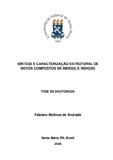| dc.creator | Andrade, Fabiano Molinos de | |
| dc.date.accessioned | 2017-05-15 | |
| dc.date.available | 2017-05-15 | |
| dc.date.issued | 2008-03-17 | |
| dc.identifier.citation | ANDRADE, Fabiano Molinos de. Sinthesis and structural characterization of new indium(II) and indium(III)compounds. 2008. 141 f. Tese (Doutorado em Química) - Universidade Federal de Santa Maria, Santa Maria, 2008. | por |
| dc.identifier.uri | http://repositorio.ufsm.br/handle/1/4159 | |
| dc.description.abstract | This work presents the synthesis and crystallographical study of indium organometallic compounds series in II and III oxidation states. Br2In(diox)2CH2Br and tetrahedral indium cluster, In4R4 [R = C(SiMe3)3], were adopted as starting materials of this work. We have made two different systematic studies: (a) reaction of Br2In(diox)2CH2Br with dialkylselenides R1SeR2 (R1 = CH3, R2 = CH2Ph; R1 = C2H5, R2 = CH2Ph; R1 = R2 = CH2Ph) and (b) reaction between the tetrahedral indium cluster and different chalcogenide donor ligands, such as PhEEPh (E = S,
Se and Te), ArTeTeAr (Ar = CH3C6H4) and PhEBr (E = Se and Te), and haloforms as well, CHX3 (X = Cl, Br and I). The haloforms were applied as mild halogen donors. Br2In(diox)2CH2Br is obtained by the direct reaction between InBr and
CH2Br2 in 1,4-dioxane. The Br3InCH2Se(CH3)CH2Ph (1), Br3InCH2Se(C2H5)CH2Ph (2) and Br3InCH2Se(CH2Ph)2 (3) derivatives are obtained by the reaction between
Br2In(diox)2CH2Br and their own dialkylselenides. Tetrahedral indium cluster is obtained by the reaction between InBr and C(SiMe3)3·2THF in equivalent amounts. The new organoindium subhalides, R2In2Cl2 (4), R2In2Br2 (5), R2In2I2 (6), and the new indium(III) dimeric compounds as well, [RIn(SPh)2]2 (7), [RIn(SePh)2]2 (8), [RIn(TePh)2]2 (9) and [RIn(ArPh)2]2 (10), [RIn(Br)SePh]2 (11), [RIn(Br)TePh]2 (12), were obtained by the direct reaction of tetrahedral indium cluster and their respective halide or chalcogenide donors. | eng |
| dc.description.sponsorship | Conselho Nacional de Desenvolvimento Científico e Tecnológico | |
| dc.format | application/pdf | por |
| dc.language | por | por |
| dc.publisher | Universidade Federal de Santa Maria | por |
| dc.rights | Acesso Aberto | por |
| dc.subject | Carbenóide | por |
| dc.subject | Cluster | por |
| dc.subject | Índio | por |
| dc.subject | Sub-haletos | por |
| dc.subject | Heterociclos | por |
| dc.subject | Carbenoid | eng |
| dc.subject | Cluster | eng |
| dc.subject | Indium | eng |
| dc.subject | Chalcogenides | eng |
| dc.subject | Sub-halides | eng |
| dc.subject | Heterocycles | eng |
| dc.title | Síntese e caracterização estrutural de novos compostos de índio (II) e índio(III) | por |
| dc.title.alternative | Sinthesis and structural characterization of new indium(II) and indium(III)compounds | eng |
| dc.type | Tese | por |
| dc.description.resumo | Este trabalho apresenta a síntese e o estudo cristalográfico de uma série de compostos organometálicos de índio nos estados de oxidação II e III. Os materiais de partida utilizados neste trabalho foram o Br2In(diox)2CH2Br e o cluster
tetraédrico de índio, In4R4 [R = C(SiMe3)3]. Realizou-se dois tipos de estudos sistemáticos: (a) reação de Br2In(diox)2CH2Br com dialquilselenetos R1SeR2 (R1 = CH3, R2 = CH2Ph; R1 = C2H5, R2 = CH2Ph; R1 = R2 = CH2Ph) e (b) reação do
cluster de índio com diferentes ligantes contendo calcogênios, como PhEEPh (E = S, Se e Te), ArTeTeAr (Ar = CH3C6H4) e PhEBr (E = Se e Te) e com halofórmios, CHX3 (X = Cl, Br e I). Os halofórmios foram utilizados como doadores de
halogênio moderados. Br2In(diox)2CH2Br é obtido através da reação entre InBr e CH2Br2 em 1,4-dioxano. Os derivados Br3InCH2Se(CH3)CH2Ph (1), Br3InCH2Se(C2H5)CH2Ph (2) e Br3InCH2Se(CH2Ph)2 (3) são obtidos através da reação entre Br2In(diox)2CH2Br e seus respectivos dialquilselenetos. O cluster tetraédrico de índio é obtido a partir da reação de InBr e C(SiMe3)3·2THF em quantidades equivalentes. Os novos derivados de halogênio, R2In2Cl2 (4), R2In2Br2 (5), R2In2I2 (6), e os novos compostos diméricos de índio(III), [RIn(SPh)2]2 (7), [RIn(SePh)2]2 (8), [RIn(TePh)2]2 (9) e [RIn(ArPh)2]2 (10), [RIn(Br)SePh]2 (11), [RIn(Br)TePh]2 (12), foram obtidos através da reação direta do cluster de índio com seus respectivos doadores de halogênio ou calcogênio. | por |
| dc.contributor.advisor1 | Peppe, Clovis | |
| dc.contributor.advisor1Lattes | http://lattes.cnpq.br/2796064506460595 | por |
| dc.contributor.referee1 | Gregório, José Ribeiro | |
| dc.contributor.referee1Lattes | http://lattes.cnpq.br/5441094963904299 | por |
| dc.contributor.referee2 | Gil, Marcelo Priebe | |
| dc.contributor.referee2Lattes | ttp://lattes.cnpq.br/9638721601182642 | por |
| dc.contributor.referee3 | Lang, Ernesto Schulz | |
| dc.contributor.referee3Lattes | http://lattes.cnpq.br/4481982189769819 | por |
| dc.contributor.referee4 | Fenner, Herton | |
| dc.contributor.referee4Lattes | http://lattes.cnpq.br/2943736272592164 | por |
| dc.creator.Lattes | http://lattes.cnpq.br/8880807687863294 | por |
| dc.publisher.country | BR | por |
| dc.publisher.department | Química | por |
| dc.publisher.initials | UFSM | por |
| dc.publisher.program | Programa de Pós-Graduação em Química | por |
| dc.subject.cnpq | CNPQ::CIENCIAS EXATAS E DA TERRA::QUIMICA | por |


